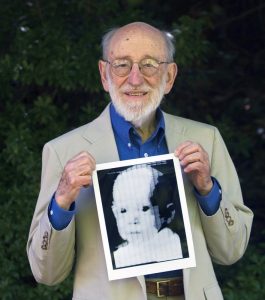Did you know the core of eBizDocs’ existence is largely the result of one man?
 We bet you never heard of him. Russell Kirsch died on August 11 at the age of 91. Russell’s contributions were remarkable, and we are thankful for his innovations. In the world of computers, the scanner is a device that optically scans images, printed or written text, a three-dimensional object, etc. and represents it in a digital format.
We bet you never heard of him. Russell Kirsch died on August 11 at the age of 91. Russell’s contributions were remarkable, and we are thankful for his innovations. In the world of computers, the scanner is a device that optically scans images, printed or written text, a three-dimensional object, etc. and represents it in a digital format.
The now ubiquitous device can be found in offices as a desktop (or flatbed) scanner, where the document is placed on a glass window for scanning.
Pixels, the digital dots used to display photos, video and more on phone and computer screens, weren’t an obvious innovation in 1957, when Kirsch created a small, 2-by-2-inch black-and-white digital image of his infant son, Walden. That was the first image scanned into a computer, using a device created by his research team at the U.S. National Bureau of Standards (now the National Institutes of Science and Technology).
This work “laid the foundations for satellite imagery, CT scans, virtual reality and Facebook,” said a 2010 Science News article about Kirsch, subsequently republished by Wired. That first square image, that article said, measured a mere 176 pixels on a side — just shy of 31,000 pixels in total. Today, the digital camera on the iPhone 11 can capture roughly 12 million pixels per image.
Though computers have become exponentially more powerful and can now fit in our pockets, science has ever since been coming to terms with the fact that Kirsch made his pixels square. The square shape of the pixels meant that image elements can look blocky, clunky or jagged — just generally not as smooth as real life. There’s even a word for this effect: “pixelated.”
“Squares was the logical thing to do,” Kirsch told the magazine in 2010. “Of course, the logical thing was not the only possibility … but we used squares. It was something very foolish that everyone in the world has been suffering from ever since.”
Kirsch later developed a method to smooth out images by using pixels with variable shapes instead of the squares.
Born in Manhattan in 1929, Kirsch was the son of Jewish immigrants from Russia and Hungary. He was educated at the Bronx High School of Science, New York University, Harvard and MIT and worked for five decades as a research scientist at the U.S. National Bureau of Standards.
Thank you Russell for making eBizDocs a reality.
About eBizDocs
eBizDocs is a premier digital transformation provider focused on helping you put INFORMATION AT YOUR FINGERTIPS. Offerings include paper and microfilm conversion, content capture and document management solutions, scanner sales and service, and process consultation. eBizDocs is SOC2 Type II certified and serves private and public-sector organizations. The company has been in business for over 20 years and is a preferred source contractor for NYS entities. To learn how eBizDocs can help transform your operation, visit eBizDocs.com

